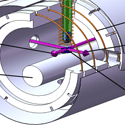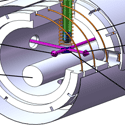Magnetic scans with a tiny magnet
Nuclear magnetic resonance is a powerful technique for analyzing molecular structure in biology, medicine, and materials science. Conventionally, it calls for huge magnets to align nuclear spins and to detect them with high sensitivity, but recent work has demonstrated that similar analysis can be done without a magnetic field. The problem with this zero-field technique is that it can’t unambiguously identify molecules. Now, in a paper in Physical Review Letters, Micah Ledbetter of the University of California, Berkeley, and his collaborators address this limitation, showing that a very small magnetic field can provide extra signatures for chemical discrimination.
Nuclear magnetic resonance (NMR) spectroscopy detects nuclei with magnetic moments, such as hydrogen, by the way they absorb energy. A strong external magnetic field can enhance the NMR signal, while also revealing chemically-specific shifts in the absorption spectrum. But these large fields can hide other molecular signatures, such as those involving magnetic interactions between nuclei.
These internuclear interactions have been observed with low-field NMR, but to increase sensitivity, researchers have reduced the fields to zero, so that certain high-precision magnetometers can be used to probe samples. The zero-field spectra do not provide a unique chemical fingerprint, since molecular groups (like and ) have nearly identical absorption lines. Therefore, the authors decided to apply very small external fields to an experimental setup designed for zero-field NMR. Their results on a variety of organic compounds showed that a field of around milligauss caused certain lines in the zero-field spectra to split up into multiple lines. This chemically specific splitting, which agrees with theory, could make “near-zero-field” NMR spectroscopy a complementary tool to its high-field cousin, the authors claim. – Michael Schirber





